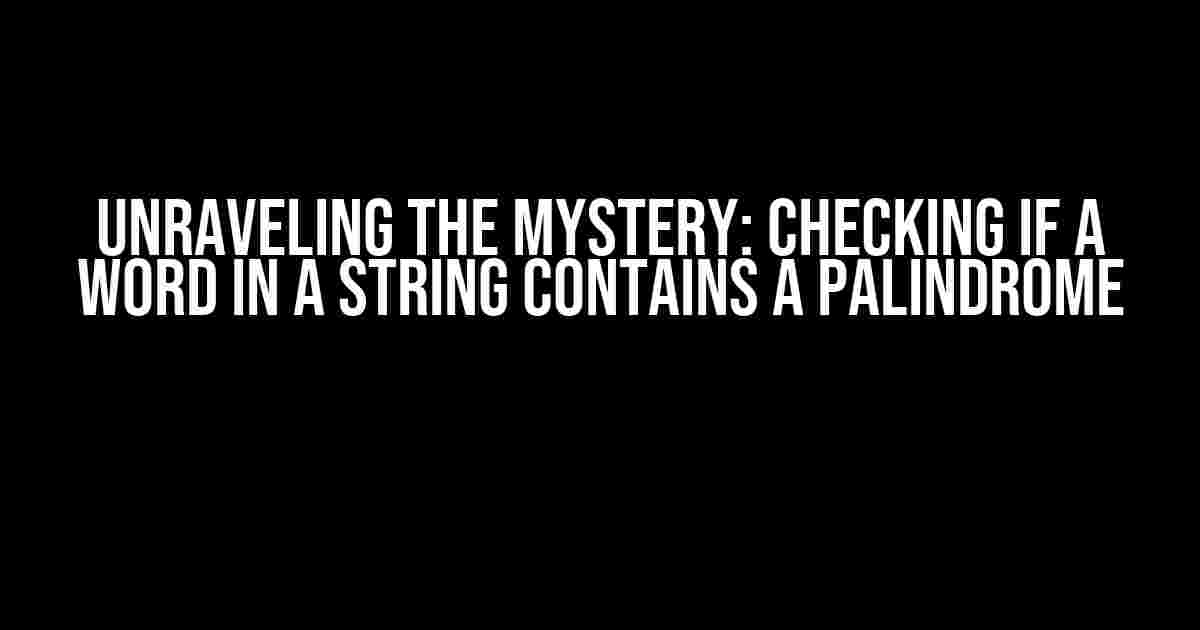Are you tired of wondering if a word in a string contains a palindrome? Do you find yourself stuck in a loop of confusion, unsure of how to tackle this problem? Fear not, dear reader, for we are about to embark on a thrilling adventure to demystify this conundrum. By the end of this article, you’ll be a master of palindrome detection, ready to take on any string that comes your way!
What is a Palindrome, You Ask?
A palindrome, put simply, is a word, phrase, or sequence that reads the same backward as forward. Examples of palindromes include “madam,” “radar,” and “level.” But what about when we’re dealing with a string containing multiple words? How do we determine if one of those words is a palindrome?
The Problem Statement
Given a string containing one or more words, write a program to check if any of the words in the string contain a palindrome. Sounds simple, right? Well, it’s not as straightforward as you might think. But don’t worry, we’ll break it down step by step.
Step 1: Tokenize the String
The first step is to split the input string into individual words. We can achieve this using a programming language’s built-in string splitting functionality. For example, in Python, we can use the `split()` method:
input_string = "hello world madam"
words = input_string.split()This will result in a list of words: `[‘hello’, ‘world’, ‘madam’]`. Now, we can iterate over each word to check if it’s a palindrome.
Step 2: Check if a Word is a Palindrome
To check if a word is a palindrome, we can use a simple algorithm:
- Reverse the word.
- Compare the reversed word with the original word.
- If they match, the word is a palindrome.
In Python, we can implement this using a function:
def is_palindrome(word):
reversed_word = word[::-1]
return word == reversed_wordThis function takes a word as input, reverses it using slicing (`word[::-1]`), and then compares it with the original word. If they match, it returns `True`, indicating that the word is a palindrome.
Step 3: Iterate over the Words and Check for Palindromes
Now that we have our `is_palindrome()` function, we can iterate over the list of words and check each one:
for word in words:
if is_palindrome(word):
print(f"{word} is a palindrome!")This will print out “madam is a palindrome!” for our example input string. But what if we want to return a list of all palindromes found in the string?
Step 4: Return a List of Palindromes
We can modify our code to store the palindromes in a list and return it:
def find_palindromes(input_string):
words = input_string.split()
palindromes = []
for word in words:
if is_palindrome(word):
palindromes.append(word)
return palindromesNow, we can call this function with our input string and get a list of palindromes:
input_string = "hello world madam"
palindromes = find_palindromes(input_string)
print(palindromes) # Output: ['madam']Edge Cases and Optimization
Our solution works, but we should consider some edge cases:
- What if the input string is empty?
- What if the input string contains punctuation or special characters?
- What if we want to ignore case when checking for palindromes?
We can address these concerns by adding some simple checks and modifications:
def find_palindromes(input_string):
if not input_string:
return []
words = input_string.lower().split() # Ignore case and split on whitespace
palindromes = []
for word in words:
word = ''.join(e for e in word if e.isalnum()) # Remove punctuation and special characters
if is_palindrome(word):
palindromes.append(word)
return palindromesThis updated function handles empty input strings, ignores case, and removes punctuation and special characters from the words before checking for palindromes.
Conclusion
And there you have it! We’ve successfully implemented a program to check if a word in a string contains a palindrome. By following these steps, you’ll be well on your way to becoming a palindrome-detection master:
- Tokenize the string.
- Check if a word is a palindrome.
- Iterate over the words and check for palindromes.
- Return a list of palindromes.
Remember to consider edge cases and optimize your solution for efficiency. With practice, you’ll be able to tackle even the most complex palindrome-related challenges that come your way!
| Language | Example Code |
|---|---|
| Python | def find_palindromes(input_string): ... |
| JavaScript | function findPalindromes(inputString) { ... } |
| Java | public List<String> findPalindromes(String inputString) { ... } |
Feel free to experiment with different languages and implementations. Happy coding!
Here are 5 questions and answers about “Checking if a word in string contains a palindrome” in a creative voice and tone:
Frequently Asked Questions
Get ready to unravel the mystery of palindromes!
What is a palindrome, and why should I care?
A palindrome is a word, phrase, or sequence that reads the same backward as forward. You should care because palindromes are like hidden treasures in language – they’re rare and fascinating! Plus, knowing how to spot them can be a game-changer for word game enthusiasts and language learners alike.
How do I check if a word in a string contains a palindrome?
You can write a function that iterates through each word in the string, and then checks if the word is the same when reversed. If it is, you’ve got a palindrome! You can use programming languages like Python or JavaScript to create such a function.
What’s an example of a word that contains a palindrome?
The word “level” is a great example! It contains the palindrome “lev-el”, which reads the same forward and backward.
Can I use regular expressions to find palindromes in a string?
Yes, you can! Regular expressions can be a powerful tool for finding patterns in strings, including palindromes. However, be warned that creating a regex pattern to match all possible palindromes can get quite complex.
Are there any real-world applications of palindrome detection?
Actually, yes! Palindrome detection has applications in data compression, error-correcting codes, and even DNA sequence analysis. It’s also used in language processing and machine learning algorithms.

